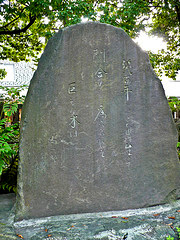
On Wednesday at Kakizakai Sensei's, I met French flautist and shakuhachi player, Véronique Piron, who together with Jim Franklin organised the European Shakuhachi Festival in summer. Despite being an intensely hot day, after the lessons, we went on a small Chichibu tour guided by Megumi and Achi. This included an enormous and fascinating antique shop that had sword cases doubling as shakuhachi cases from Japanese patterned fabric and indigo dyed, as well as more bizarre items like an old armadillo, stuffed fox, giant dragonhead-shaped woodblocks that were impractical but very cool, endless trinkets, a taiko drum, beautiful old wooden chests of drawers, furniture, swords, crockery and so on, followed by the main shrine of Chichibu. Given that this is a 'shrine town' in which pilgrims can tour a vast number of shrines and temples, some much more virtuous to reach than others, on steep mountain-tops and more remote parts, we were fortunate that the main one is in town and very accessible, guarded by a host of loudly singing cicadas.















 [Commemoration stone with Tanka by Kakizakai Senior. The poem inscribed is a dedication traditional Japanese poem by Kakizakai Sensei's father].
[Commemoration stone with Tanka by Kakizakai Senior. The poem inscribed is a dedication traditional Japanese poem by Kakizakai Sensei's father]. The motifs used on the walls and sculptures are animals and characters of Japanese mythology. The most famous, a dragon and tigers, are attributed to Master sculptor, Hidari Jingoro (who may in fact be a legendary figure). The building was reassembled due to a typhoon in 1966 and restored in 1970. Major events at the Chichibu Shrine include Setsubun in early February, the Rice-Planting Festival on 4 April, Kawase Matsuri in July, and the great night festival culminating on 3 December. This is considered one of Japan's three biggest festivals of float (along with Gion in Kyoto and Hikiyama of Takayama). The architectural plan of Chichibu Shrine is oriented towards Mount Buko. It is dedicated to 3 gods of Japanese mythoology and to the late Prince Chichibu, though the shrine might also lead back to animistic worship of Mt. Buko (according to Sumiko Enbutsu's Chichibu: Japan's Hidden Treasure book). Many Shinto shrines were dedicated to the worship of prominent mountains, rocks or trees. The forest was called Hahaso-no-mori and Mt. Buko was formerly called Mt. Chichibu, thus the forest and the mountain's names including the terms 'haha' and 'chichi' (for 'mother' and 'father'). This dualism, common in ancient religions, is celebrated in the finale of the December festival. In historic times, there was also a Buddhist temple, Zofuku-ji, around this location and for a long time the shrine was called Chichibu Myooken-Jinja. The nearby streets used to be the locale of the nineteenth century silk merchants right into the Meiji area, when the silk trade brought prosperity to the region.
On the way home, at Shibuya Midori Souhonten, Véronique and I had delicious a la carte sushi of the most fresh and artfully created kind.
From Véronique's web site ...
Véronique PIRON, born in 1961, is a professional French flutist, and a Shakuhachi player since 1992. She started to work in France with IWAMOTO Yoshikazu and then in Japan with YOKOYAMA Katsuya and FURUYA teruo, and practiced there with many shamisen and koto players as she got a “Lavoisier” scholarship from the French Foreign Affairs Ministry between 2000 and 2002. She has a SHIHAN licence from YOKOYAMA Katsuya, and got a French State Degree in 2004 for teaching Shakuhachi and Japanese Music. From 2004 she created a workshop about Japanese Traditional Music and a Shakuhachi Class in the State Music School where she is teaching flute, and is trying to extend this teaching into appropriate places in France as those concerned about traditional music. Veronique presents regularly the Shakuhachi inside the Music Museum (Cite de la Musique) in Paris, gives concerts in her country and participates in International Concerts as the International Shakuhachi Summit in Tokyo in 2002. Presently as she is leaving in West part of France from Celtic culture, she is starting a creative and sharing work with representative musicians there. She has an actualite (activity) shakuhachi blog - nipponflutes.





